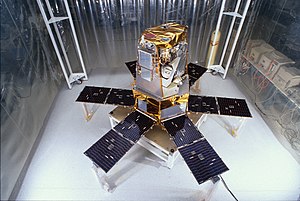 Solar Radiation and Climate Experiment satellite | |
| Names | SORCE |
|---|---|
| Mission type | Astrophysics |
| Operator | NASA, LASP at University of Colorado Boulder |
| COSPAR ID | 2003-004A |
| SATCAT no. | 27651 |
| Website | https://lasp.colorado.edu/sorce/ |
| Mission duration | 5 years (planned) 21 years, 9 months and 22 days (in orbit) |
| Spacecraft properties | |
| Spacecraft type | Solar Radiation and Climate Experiment |
| Launch mass | 315 kg (694 lb) |
| Dry mass | 290 kg (640 lb) |
| Start of mission | |
| Launch date | 25 January 2003, 20:13:35 UTC |
| Rocket | Pegasus XL |
| Launch site | Cape Canaveral (CCAFS), Lockheed L-1011 TriStar |
| Contractor | Orbital Sciences Corporation |
| End of mission | |
| Disposal | Decay in 2032 (planned) |
| Deactivated | 25 February 2020 |
| Orbital parameters | |
| Reference system | Geocentric orbit[1] |
| Regime | Geosynchronous orbit |
| Altitude | 645 km (401 mi) |
| Inclination | 40.00° |
| Period | 97.19 minutes |
| Instruments | |
| TIM - Total Irradiance Monitor SOLSTICE - Solar Stellar Irradiance Comparison Experiment SIM - Spectral Irradiance Monitor XPS = XUV Photometer System | |
The Solar Radiation and Climate Experiment (SORCE) was a 2003–2020 NASA-sponsored satellite mission that measured incoming X-ray, ultraviolet, visible, near-infrared, and total solar radiation.[2] These measurements specifically addressed long-term climate change, natural variability, atmospheric ozone, and UV-B radiation, enhancing climate prediction. These measurements are critical to studies of the Sun, its effect on the Earth's system, and its influence on humankind. SORCE was launched on 25 January 2003 on a Pegasus XL launch vehicle to provide NASA's Earth Science Enterprise (ESE) with precise measurements of solar radiation.
SORCE measured the Sun's output using radiometers, spectrometers, photodiodes, detectors, and bolometers mounted on a satellite observatory orbiting the Earth. Spectral measurements identify the irradiance of the Sun by characterizing the Sun's energy and emissions in the form of color that can then be translated into quantities and elements of matter. Data obtained by SORCE can be used to model the Sun's output and to explain and predict the effect of the Sun's radiation on the Earth's atmosphere and climate.
Flying in a 645 km (401 mi) orbit at a 40.0° inclination, SORCE was operated by the Laboratory for Atmospheric and Space Physics (LASP) at the University of Colorado Boulder, Colorado. It continued the precise measurements of total solar irradiance that had begun with the ERB instrument in 1979 and had been later extended with the ACRIM series of measurements (1999+). SORCE provided measurements of the solar spectral irradiance from 1 to 2000 nm, accounting for 95% of the spectral contribution to the total solar irradiance.
- ^ "SDO 2010-005A". N2YO. 24 January 2015. Retrieved 25 January 2015.
- ^ "SORCE". LASP. Archived from the original on 10 February 2012. Retrieved 19 October 2011.
 This article incorporates text from this source, which is in the public domain.
This article incorporates text from this source, which is in the public domain.